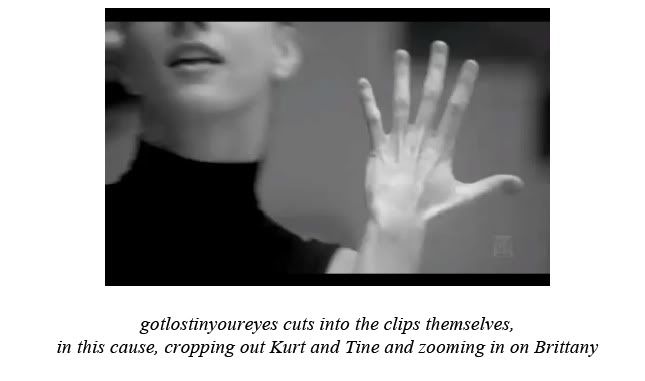Vidding Glee
Posted in The Gnovis Blog
My personal history with online media fandom extends back to when I was eleven or twelve and first discovered slash fanfiction, which takes characters from books, television programming, and films and uses them as points of departure for queer romance and erotica. For a young gay boy who had very few other venues for the consumption of such narratives, this was, predictably perhaps, a pretty big moment.
Since then, my horizons have been broadened a bit to a whole series of transformative fanworks that take media, cut them up, pull out their signifies, and do with them any number of new things. One such practice is vidding, which Trish has done an excellent job of introducing in her post here, and which will be the topic of a lecture by Georgetown Law Professor Rebecca Tushnet on Thursday, January 28 at 12:15 pm in Car Barn 317.
To expand on Trish’s introduction and hopefully encourage an audience for Prof. Tushnet’s talk, I thought I would take a stab at narrativizing a single vid as a short case study and point of first contact for people unfamiliar with the practice. I’ve chosen one of my recent favorites by a fan I respect very much, gotlostinyoureyes (fan names are customarily written all in lower case). I know a lot of us have been caught up in this fall’s run away hit, Glee, so I chose her piece, “Gimmie More – A Brittany Vid,” for a closer look.
This example shows a simple and straightforward example of the way that this particular form of audio-visual remix also serves as an intervention into the televisual text, itself. In this case, gotlostinyoureyes is expressing an affinity for a minor character that she would like to see get more attention. This is ascertained by the viewer by reading the visuals against the lyrics of the chosen song, the pairing of which is the primary tool of communication the vidder is working with.
In certain moments of the vid, gotlostinyoureyes matches images from the show with lyrics that literalize their verbal signs such as Kurt’s video camera over the line, “cameras are flashin’,” the Cheerios dancing during a meeting of the school’s celibacy club during the line, “now we’re dirty dancin’,” and the glee club boys watching their female counterparts performing their mashup during the show choir battle of the sexes over the phrase, “keep watchin’.” This creates cohesion between the audio and the video so that other moments can be used to build her argument. For example, over the line, “public display of affection,” gotlostinyoureyes uses a clip of Kurt staring at the object of his secret crush, Finn, but cuts starting from a moment in the camera’s pan towards him where Finn is no longer in the frame and it looks like he’s staring at Brittany. In that clip, then, the vidder substitutes Kurt for herself in order to express her love for the character.
Every frame of “Gimme More” includes Brittany, but because she does not receive much screen time in the show, gotlostinyoureyes is forced to use several clips which have her in the background. It is a function of the montage-element of vidding that the viewer is encouraged to connect the images they are shown, in this case, forcing them to find Brittany in the frame even when they might not have paid attention to her when they saw the same images in their original contexts of the episodes.
gotlostinyoureyes also deals with the lack of Brittany-focused footage by intervening in the frames she is given. In order to extend the use of the only scene in the entire first season which shows Brittany alone in the frame, she slows the clip down on its first run, reverses it and plays it again. She then deploys individual pieces of it in rapid succession, eventually showing the same footage over fifteen times, each with slight variations. Near the conclusion of the piece, she also takes an earlier shot of Brittany dancing with Kurt and Tina and cuts the other two characters out of the frame, zooming in on Brittany’s face and hands.
Beyond the lyrics, the non-verbal element of the song also plays a role in the meaning made in a vid. A vidder may or may not select a song because of changes in the music over time, which helps to specify the narrative flow they are trying to achieve, but they consistently consider the mood of the vid when choosing the song. In the case of “Gimme More,” gotlostinyoureyes sets a fun, upbeat tone in her examination of Brittany as part of her project of showing the character’s appeal and, by extension, worthiness to be granted more focus within the show’s narrative.
Although the degree to which a particular character is centralized within a tv narrative may seem trivial, this community of practice is producing a creative form of critique that can be leveled at any number of issues. As I mentioned above, transformative works are famous for dealing with the lack of gay content in mainstream media by moving subtext to text or inventing it altogether. Multiple vids have dealt with racism, the erasure of characters of color, and cultural appropriation. And some even take on debates of cyborgism and post-human anxiety. Then again, many are based on criticism simply founded in what relationships a vidder would find hot, what characters they like, and which they identify with, but even these messages should not be looked on as unimportant as an expression of an individual viewer’s experience of a given text.
So my take away in all of this? In a media environment frequently thought to be dominated by simple one-way communication, the fans actually do talk back.



